Welcome to the Queensland Begonia Society.
The Queensland Begonia Society was formed in October 1988 by Peter Henderson and Michael O’Dea. In the early 2010s, it has about 130 members in Brisbane, Queensland, Australia, France and USA, as well as Japan, Sweden and Scotland in the past.
The Society meets at 1pm in the Merthyr Uniting Church Hall, 52 Merthyr Rd, New Farm, Brisbane, Queensland, Australia, on the 3rd Saturday of each month (excluding December).
The trade table opens at 12.15pm for purchases of plants and cuttings. The administrative items are kept as brief as possible to allow the bulk of the meeting to be devoted to begonias.
Regular segments of each meeting include cultural information, problems, plant identification, two-minute talks, talks on a particular species, a raffle, access to the library, the show bench (which has sections for “Set Subject”, “Open Subject” and “Novice”) with the exhibits judged by popular vote, and afternoon tea.
The society issues four journals each year and organises field days for its members.
Fees are $25 single and $30 family from 1st January, or $12.50 single and $15 family from 1st July. The society accepts both local and international memberships, subscriptions and sponsorships.
In addition to the eleven monthly meetings, the Annual Show of Begonias is held at Mt Coot-tha Botanic Gardens Auditorium in February of each year. This is the largest and only show of Begonias in Queensland, where visitors can:
- Admire quality begonias in many competition classes.
- View artistic static displays of diverse begonias, including endangered species, new hybrids and rare varieties.
- Meet experienced growers and dedicated members of the society.
- Purchase many varieties of begonias not available through normal nurseries.
- Buy books published by the society.
- Make inquiries or seek assistance at the information desk.
- Participate in the “Name This Begonia” competition.
- Witness the award of competition trophies.
- Attend plant workshops at 10am and 11:30am.
- Win raffle prizes.
- Enjoy light refreshments.
Contact
For further information, please kindly contact the Queensland Begonia Show Organiser Shevanti Seneviratne on (07) 5502 2579 or by 📧 Email to shevi71b@gmail.com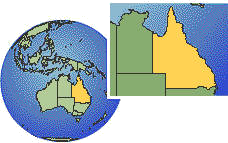
☎️ Phone: (07) 3353 1131
📳 Mobile: 0468 373 123
📧 Email: phil.dulcie@bigpond.com
Contact the Honorary Secretary of the Queensland Begonia Society:
Email: Poinsettia42@hotmail.com
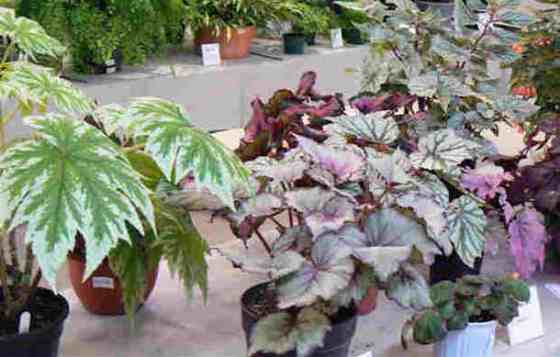
The Queensland Begonia Society Annual Begonia Show features competition benches (30 classes) plus static displays in the auditorium of Brisbane Botanic Gardens at Mt Coot-tha. The show includes an information desk as well as books and plants for sale. Light refreshments are also available.
- To promote good fellowship amongst all people interested in begonias and in horticulture generally.
- To hold regular meetings for the examination and exhibition of begonias.
- To publish a regular newsletter and other books and/or papers, which disseminate and assist in the educational advancement of begonias and their allied fields.
- To hold periodic exhibitions, seminars, lectures and any other activities considered by the management committee of the society to be consistent with the advancement of begonias in all its branches.
Click here to learn more about Begonias🍃
In 1998, during a chance conversation with Michael O’Dea at a show in the auditorium of Brisbane Botanic Gardens at Mt Coot-tha, Peter Henderson mentioned that his wife, Enid Henderson, was fairly keen on begonias, and that he had suggested to her on more than one occasion that she should get a few begonia enthusiasts together to form a club dealing exclusively with begonias.
Michael’s reply was along the lines of “Why don’t we get it going?”. And so it eventuated that Peter compiled a lists of as many begonia growers as he could find, and Michael found and booked a suitable hall (at 52 Merthyr Road, New Farm). Michael also arranged for Enid Henderson, Patricia O’Dea (Michael’s late wife) and Linda Laker to put on a display of begonias at the Royal Horticultural Society of Queensland (RHSQ) Show in October 1988 to generate interest.
Peter issued the invitations on 29 September 1988 for the first meeting on Saturday 15 October. Twenty two keen people turned up. Michael very capably chaired the meeting and led the meeting through all the decisions to be made to set up the society. All the official positions were filled, with Michael being elected as the first president. The general theme and direction of the society were agreed upon.
As the news spread, membership increased rapidly in the first year, during which the excellent newsletter was commenced and the first annual show was held. By November 1991, the Queensland Begonia Society had 120 members, some of whom traveled from as far away as Gympie, Toowoomba, Ipswich and other outer areas to attend monthly meetings.
Although it might be said that Michael and Peter initiated the move to form the society, it really was the willingness of the people who took all the various tasks which breathed life into the fledgling society.
The society has had a wonderful start, and with the continued willingness of members to be involved and so share the workload, together with the maintenance of the friendly atmosphere that exists, it is certain that the society will continue to grow and benefit all begonia lovers throughout Queensland, and hopefully, also begonia enthusiasts from other parts of Australia and the world.
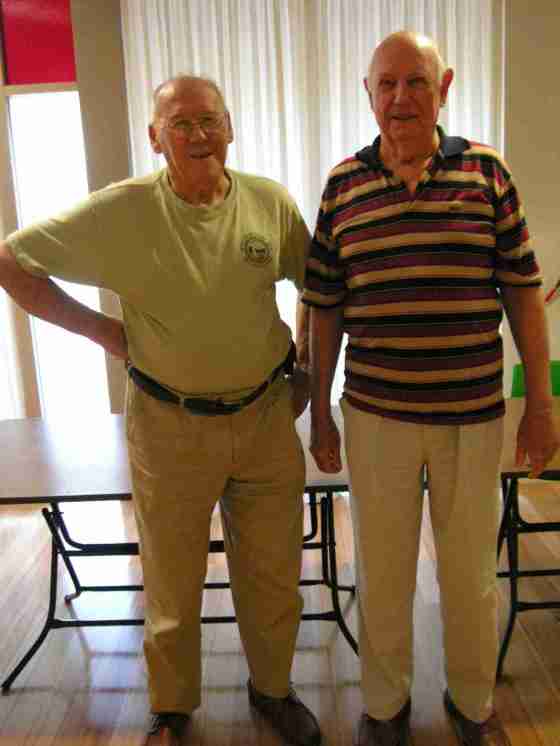
Michael O’Dea & Peter Henderson
Photographed by SoundEagle around 4pm on 12 May 2012 at Merthyr Uniting Church Hall, 52 Merthyr Road, New Farm, Brisbane, Queensland 4005, Australia.

| Begonia | |
|---|---|
 |
|
| Begonia cultivars | |
| Scientific classification |
|
| Kingdom: | Plantae |
| clade: | Angiosperms |
| clade: | Eudicots |
| clade: | Rosids |
| Order: | Cucurbitales |
| Family: | Begoniaceae |
| Genus: | Begonia L. |
| Species Click here to see text below  Range of the genus Begonia Range of the genus Begonia |
|
Begonia is a genus in the flowering plant family Begoniaceae and is a perennial. The only other members of the family Begoniaceae are Hillebrandia, a genus with a single species in the Hawaiian Islands, and the genus Symbegonia which was annexed to Begonia in 2003, as molecular phylogenies had shown it to be derived from within that genus. “Begonia” is the common name as well as the generic name for all members of the genus. Coined by Charles Plumier, a French patron of botany, the genus name honours Michel Bégon, a former governor of the French colony of Haiti. It was later adopted by Carl Linnaeus, the father of modern taxonomy who formalised binomial nomenclature. As a member of the order Curcurbitales, begonias are relatively closely related to such food crops as pumpkins/squash, gourds, cucumbers and melons.
Contents |
| Wikispecies has information related to: Begonia |
Description
Estimated to be around 1,800 species, Begonia is the sixth largest angiosperm genus.[1] The species are terrestrial (sometimes epiphytic) herbs or undershrubs and occur in subtropical and tropical moist climates, in South and Central America, Africa and southern Asia. Terrestrial species in the wild are commonly upright-stemmed, rhizomatous or tuberous. The plants are monoecious, with unisexual male and female flowers occurring separately on the same plant, the male containing numerous stamens, the female having a large inferior ovary and two to four branched or twisted stigmas. In most species the fruit is a winged capsule containing numerous minute seeds, although baccate fruits are also known. The leaves, which are often large and variously marked or variegated, are usually asymmetric (unequal-sided). Some species are commonly grown indoors as ornamental houseplants in cooler climates. In warmer climates, some species are cultivated outside in summertime for their bright colourful flowers, which have sepals but no petals.
Nomenclature
The nomenclature of begonias can be very complex and confusing. The term Picotee refers to an edging on the petals that is in contrast to the colour of the main petal, if the colours blend. If they do not, then the term Marginata is used, but sometimes these terms are used simultaneously.[2] Non-Stop refers to a Camellia tuberous hybrid that under certain conditions will bloom ‘non-stop’ all year round.
Many species and innumerable hybrids and cultivars are cultivated for their sometimes showy flowers of white, pink, scarlet or yellow colour and often attractively marked leaves. The genus is unusual in that species throughout the genus, even those coming from different continents, can frequently be hybridized with each other, and this has led to an enormous number of cultivars. The American Begonia Society classifies begonias into eight major groups below. Click any group from the following list to access all posts corresponding to the group:
- cane-like
- shrub-like
- tuberous
- rhizomatous
- semperflorens (or wax begonias)
- rex
- trailing-scandent
- thick-stemmed
For the most part these groups do not correspond to any formal taxonomic groupings or phylogeny, and many species and hybrids have characteristics of more than one group, or do not fit well in any of them.
Binomial terms such as Begonia grandiflora, Begonia multiflora and Begonia pendula do not refer to accepted species, but rather varieties of tuberous begonias.[3]
Cultivation
The different groups of begonias have different cultural requirements but most species come from tropical regions and therefore they and their hybrids require warm temperatures. Most are forest understory plants and require bright shade; few will tolerate full sun, especially in warmer climates. In general, begonias require a well-drained growing medium that is neither constantly wet nor allowed to dry out completely. Many begonias will grow and flower year-round except for tuberous begonias, which usually have a dormant period, during which the tubers can be stored in a cool and dry place. Begonias of the semperflorens group (or wax begonias) are frequently grown as bedding plants outdoors. A recent group of hybrids derived from this group is marketed as “Dragonwing Begonias”; they are much larger both in leaf and in flower. Tuberous begonias are frequently used as container plants. Although most Begonia species are tropical or subtropical in origin, the Chinese species B. grandis is hardy to USDA hardiness zone 6 and is commonly known as the “hardy begonia”. Most begonias can be grown outdoors year-round in subtropical or tropical climates, but those grown in temperate climates are treated as annuals, or as house or greenhouse plants.
Most begonias are easily propagated by division or from stem cuttings. In addition, many can be propagated from leaf cuttings or even sections of leaves, particularly the members of the rhizomatous and rex groups.
Popular Culture
Kimjongilia is a flower named after the late North Korean leader Kim Jong-il. It is a hybrid cultivar of tuberous begonia, registered as Begonia × tuberhybrida ‘Kimjongilhwa’. When Kim Jong-il died in December 2011 the flower was used to adorn his corpse for public display. Despite its name, the Kimjongilia is not the official national flower of North Korea, which is the Magnolia sieboldii.
The Grateful Dead wrote the popular song “Scarlet Begonias“. The lyrics were written by Robert Hunter and the music by Jerry Garcia. The live debut of “Scarlet Begonias” came on March 23, 1974 at the Cow Palace in Daly City, California. The song begins in Grosvenor Square in London and also references “Tea for Two” from No, No, Nanette by Irving Caesar and Vincent Youmans. The recording first appears on the 1974 release From the Mars Hotel. When “Fire on the Mountain” was incorporated into the band’s repertoire in 1977, “Scarlet Begonias” would often be paired with it when played live, resulting in what would be nicknamed “Scarlet > Fire”.
A contemporary American artist from San Francisco, Begonia Blossom Herbert is “a painter, photographer, graphic designer, writer and on occasion … playing the drums, singing or strumming the guitar.”
In the 1993 American comedy Mrs Doubtfire, a goat eats a begonia belonging to Miranda Hillard (played by Sally Field) during her son’s birthday party.
Most begonias are sour to the taste, and some people in certain areas eat them. Consuming begonias is safe in small amounts but potentially toxic in large quantities due to the prevalence of oxalic acid in the tissues. Those who are interested in treating begonias as food may read the post entitled “Edible Begonias” to learn more about begonias as edible plants that have been grown around the world both as food and as ornamentals.
Species and Cultivars
Species
- Begonia acerifolia
- Begonia acetosa Vell.
- Begonia adpressa
- Begonia aequatorialis
- Begonia aequilateralis
- Begonia aeranthos
- Begonia albo-picta W.Bull
- Begonia argenteo-guttata
- Begonia asympeltata
- Begonia auriculata Hook.
- Begonia bataiensis Kiew
- Begonia boliviensis
- Begonia bonus-henricus
- Begonia bowerae (“boweri”) Ziesenh.
- Begonia brandbygeana
- Begonia brevicyma C.DC.
- Begonia broussonetiifolia A.DC.
- Begonia cardiocarpa Liebm.
- Begonia carletonii Standl.
- Begonia carpinifolia Liebm.
- Begonia cavaleriei
- Begonia coccinea
- Begonia compacticaulis
- Begonia conchifolia A. Dietr.
- Begonia consobrina
- Begonia convallariodora C. DC.
- Begonia cooperi C. DC.
- Begonia copeyana C. DC.
- Begonia corredorana C. DC.
- Begonia cucullata var. cucullata Willd.
- Begonia davisii Hook. f.
- Begonia dentatobracteata
- Begonia dichroa
- Begonia dodsonii
- Begonia dregei
- Begonia duncan-thomasii
- Begonia eiromischa Ridl.
- Begonia estrellensis C. DC.
- Begonia exalata
- Begonia fischeri Schrank
- Begonia foliosa Kunth
- Begonia foliosa var. miniata (syn. Begonia fuchsioides Hook.)
- Begonia froebelii
- Begonia furfuracea
- Begonia fusicarpa Irmsch.
- Begonia geminiflora
- Begonia glabra Aubl.
- Begonia goegoensis Br. N.E.
- Begonia grandiflora Knowles & Westc. (syn. Begonia octopetala L’Hér.)[4]
- Begonia grandis Dryand.
- Begonia guaduensis Kunth
- Begonia hainanensis
- Begonia harlingii
- Begonia hemsleyana
- Begonia heracleifolia Cham. & Schltdl.
- Begonia heydei C. DC.
- Begonia hirsuta Aubl.
- Begonia hitchcockii
- Begonia holmnielseniana
- Begonia ignea (Klotzsch) Warsz. ex A. D.C.
- Begonia imperialis Lem.
- Begonia involucrata Liebm.
- Begonia listida
- Begonia ludwigii
- Begonia lugonis
- Begonia macrocarpa Warb.
- Begonia maculata
- Begonia mannii Hook.f.
- Begonia masoniana
- Begonia metallica
- Begonia multinervia Liebm.
- Begonia napoensis
- Begonia natalensis
- Begonia nelumbiifolia Schltdl. & Cham.
- Begonia neoharlingii
- Begonia oaxacana A. DC.
- Begonia obliqua
- Begonia octopetala L’Héritier
- Begonia oellgaardii
- Begonia oxyanthera
- Begonia oxyloba Welw. ex Hook.f.
- Begonia palmata
- Begonia parcifolia
- Begonia parviflora Poepp. & Endl.
- Begonia pearcei
- Begonia pectennervia
- Begonia pedatifida
- Begonia pelargoniiflora
- Begonia peltatifolia
- Begonia plebeja Liebm.
- Begonia preussii
- Begonia pseudoviola
- Begonia quaternata L. B. Sm. & B. G. Schub.
- Begonia rajah Ridl.
- Begonia rex Putz.
- Begonia roxburghii
- Begonia salaziensis
- Begonia schaeferi
- Begonia scharffii Hook.
- Begonia schmidtiana Regel
- Begonia secunda
- Begonia seemanniana A. DC.
- Begonia semhaensis
- Begonia semiovata Liebm.
- Begonia sericoneura Liebm.
- Begonia serotina
- Begonia socotrana
- Begonia sodiroi
- Begonia sparreana
- Begonia strigillosa A. Dietr.
- Begonia sutherlandii Hook.f.
- Begonia tetrandra
- Begonia tiger
- Begonia tonduzii C. DC.
- Begonia triramosa
- Begonia tropaeolifolia
- Begonia truncicola
- Begonia udisilvestris C. DC.
- Begonia urophylla Hook.
- Begonia urticae L. f.
- Begonia valvata
- Begonia veitchii
- Begonia venosa Skan.
- Begonia vestita C. DC.
- Begonia xerophyta
- Begonia ynesiae

Cultivars and Cultivar Groups
- Angel wing begonia (hybrid)
- Begonia ‘Immense’
- Begonia × sedenii
- Begonia × semperflorens-cultorum hort.
- Begonia × tuberhybrida Voss – Tuberous begonias (cultivar group)
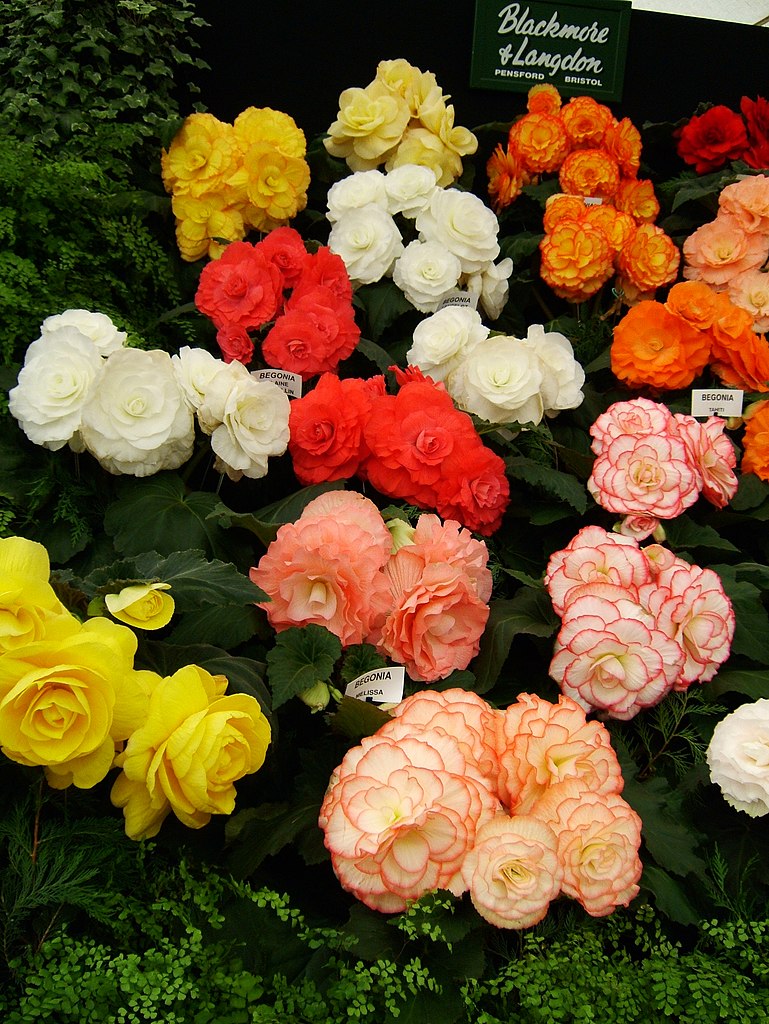
Display of tuberous begonias, Hampton Court Flower Show
Gallery
References and External Links
| Wikimedia Commons has media related to: Begoniaceae |
- ^ David G. Frodin (2004). “History and concepts of big plant genera”. Taxon 53 (3): 753–776. DOI :10.2307/4135449 . JSTOR 4135449 .
- ^ University of Vermont: Plant and Soil Science Department
- ^ 1er Jardin
- ^ The Plant List
 Chisholm, Hugh, ed. (1911). “Begonia “. Encyclopædia Britannica (11th ed.). Cambridge University Press.
Chisholm, Hugh, ed. (1911). “Begonia “. Encyclopædia Britannica (11th ed.). Cambridge University Press.- American Begonia Society
- W. S. Hoover et al. 2004, Notes on the geography of South-East Asian Begonia and species diversity in montane forests
- Phylogenetic Relationships of the Afro-Malagasy Members of the Large Genus Begonia Inferred from trnL Intron Sequences
- A Phylogeny of Begonia Using Nuclear Ribosomal Sequence Data and Morphological Characters
Gallery of Species Begonia
Related Articles 📰
- Begonia (queenslandbegonia.wordpress.com)
- About (queenslandbegonia.wordpress.com)
- Gallery (queenslandbegonia.wordpress.com)
- Journals (queenslandbegonia.wordpress.com)
- Experimental Cross of Rex and Tuberous Begonias (queenslandbegonia.wordpress.com)
- 🍃 Queensland Begonia Society Featured on SchoolAndCollegeListings 🏫🏦📝 (queenslandbegonia.wordpress.com)
- 🍃 Queensland Begonia Society One-Day Plant Sale at Belmont Shooting Centre (queenslandbegonia.wordpress.com)
- 2022 Annual Show 🍃 Begonias 🎨 Come and See 👁 Join the Queue 👨👨👧👦 (queenslandbegonia.wordpress.com)
- 2021 Annual Show 🍃 Begonias are Fun to Grow (queenslandbegonia.wordpress.com)
- 2020 Annual Show of Begonias: 🍃Aplenty🎨 (queenslandbegonia.wordpress.com)
- 2019 Annual Show of Begonias: 🍃Bold & Beautiful🎨 (queenslandbegonia.wordpress.com)
- 2017 Annual Show of Begonias for a Burst of Colour 🎨 (queenslandbegonia.wordpress.com)
- 2016 Annual Show of Begonias on Parade (queenslandbegonia.wordpress.com)
- 2015 Annual Show of Begonias in Tropical Splendour (queenslandbegonia.wordpress.com)
- 2014 Annual Show of Begonias (queenslandbegonia.wordpress.com)
- 2013 Annual Show of Begonias (queenslandbegonia.wordpress.com)
- Gallery of 2013 Annual Begonia Show (queenslandbegonia.wordpress.com)
- Gallery of 2012 Annual Begonia Show (queenslandbegonia.wordpress.com)
- 2012 Annual Show (queenslandbegonia.wordpress.com)
- Videos (queenslandbegonia.wordpress.com)
- Edible Begonias (queenslandbegonia.wordpress.com)
- Begonia ‘Dancing Girl’ (queenslandbegonia.wordpress.com)
- Pot Sizes (queenslandbegonia.wordpress.com)
- Propagating Cane Begonias (queenslandbegonia.wordpress.com)
- Green Thumb Tip #21: The Mid-Summer Snack (forestgardenblog.wordpress.com)
- Pot Shots: Begonia Love (forestgardenblog.wordpress.com)
- Fabulous Friday: B. ‘Sofia’ Blooms (forestgardenblog.wordpress.com)
- Blossom XXVI: Angel Wing Begonia (forestgardenblog.wordpress.com)
- Winter Houseguests: The Begonias (forestgardenblog.wordpress.com)
- Beloved Begonias (forestgardenblog.wordpress.com)
- Begonias: The Ultimate House Plant (forestgardenblog.wordpress.com)
- Mystery Begonia (forestgardenblog.wordpress.com)
- Bountiful Begonias (forestgardenblog.wordpress.com)
- B. “Gryphon” Blooms (forestgardenblog.wordpress.com)
- B. “Sophia” Has Bloomed! (forestgardenblog.wordpress.com)
- Hardy Begonias- “A Pass Along Plant” (forestgardenblog.wordpress.com)
- Begonias, Begonias (forestgardenblog.wordpress.com)
- Begonia Beguiled (rainbowlightningwoman.wordpress.com)
- I have always hated begonias (personal) (everything2.com)
- Annual Performance Review. (floweryprose.com)
- Hardy Begonias (forestgardenblog.wordpress.com)
- BEAUTIFUL BEGONIAS (2013 edition) (travelingrainvilles.typepad.com)
- Writers, Mothers, and Begonias (freedanichols.wordpress.com)
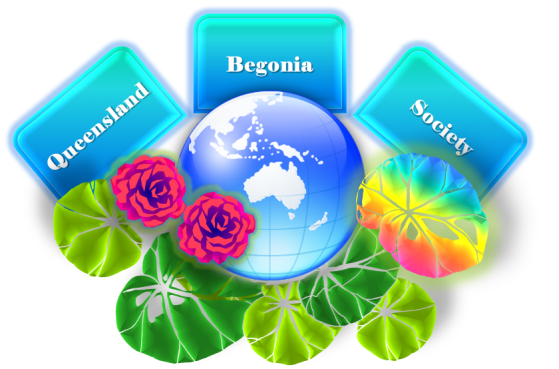
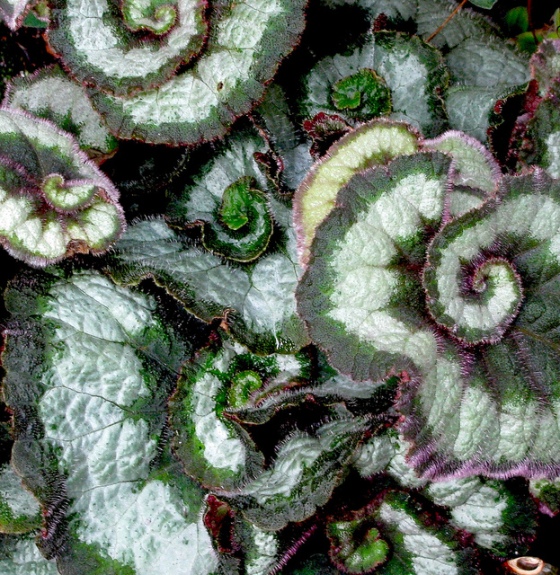



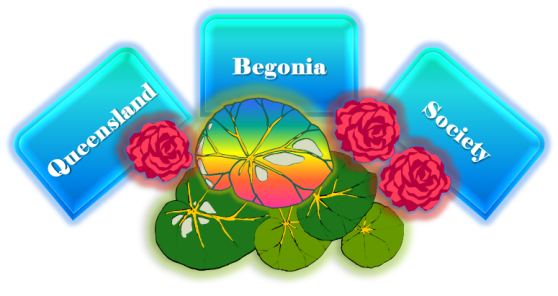
 Queensland Begonia Society Forum
Queensland Begonia Society Forum Queensland Begonia Society on Instagram
Queensland Begonia Society on Instagram Queensland Begonia Society on Facebook (newer)
Queensland Begonia Society on Facebook (newer) Queensland Begonia Society on Facebook (older)
Queensland Begonia Society on Facebook (older)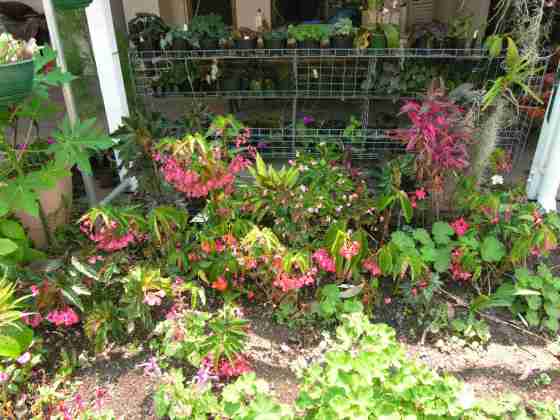
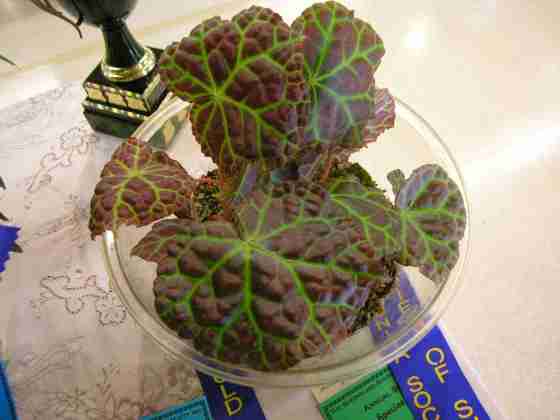
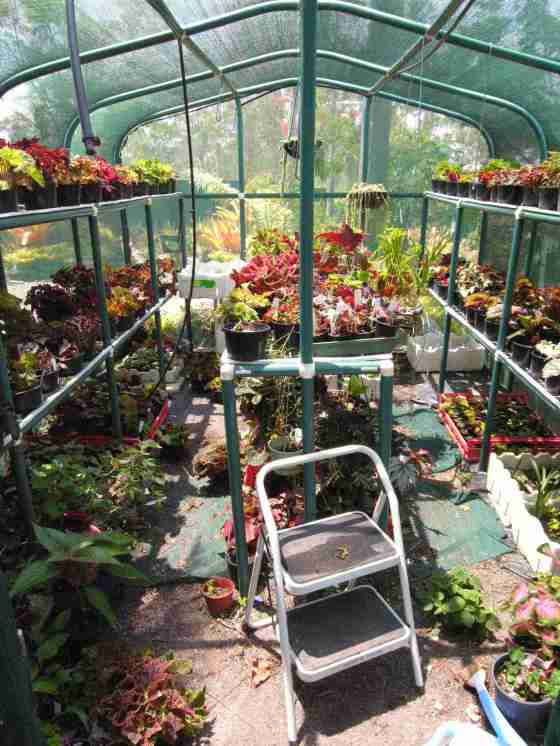
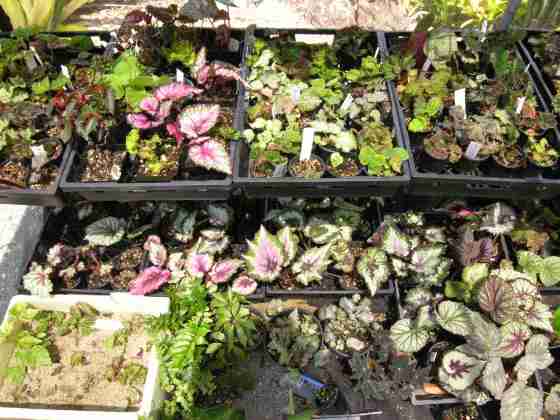



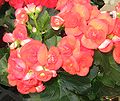














































[…] Queensland Begonia Society 🍃🌿ღೋ (soundeagle.wordpress.com) […]
LikeLike
[…] Queensland Begonia Society 🍃🌿ღೋ (soundeagle.wordpress.com) […]
LikeLike